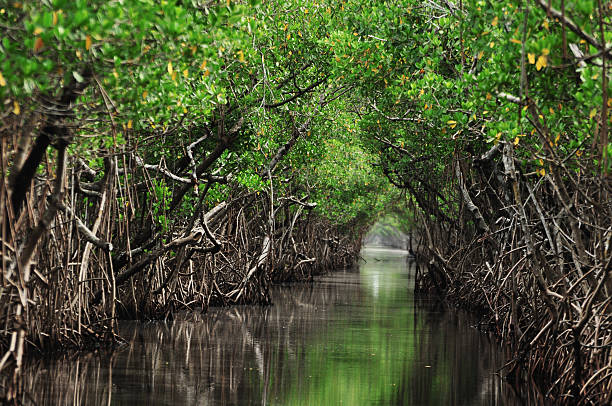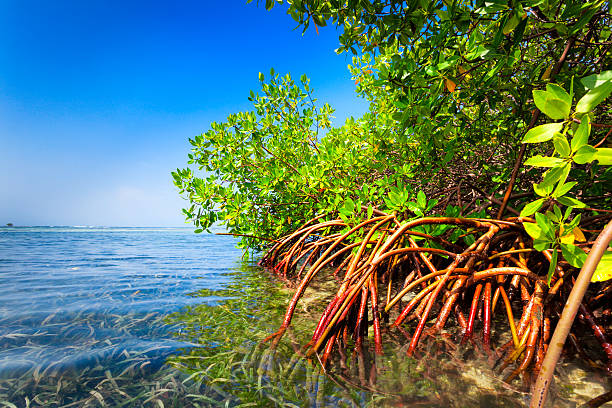Introduction
Climate of the Mangrove Forest: The Sundarbans, a UNESCO World Heritage Site situated in the Bay of Bengal, is renowned for its enchanting mangrove forests and diverse wildlife. Apart from its rich biodiversity, the Sundarbans possesses a unique climate that plays a crucial role in shaping the ecosystem.

In this blog post, we will delve into the climex (climate index) of the Sundarbans, exploring its distinctive features, the factors influencing its climate, and the implications for the flora, fauna, and local communities. Let’s know some more informetion about Climate of the Mangrove Forest.
Understanding the Sundarbans Climate
The Sundarbans experiences a tropical monsoon climate, characterized by hot, humid summers and mild winters. The region lies in the coastal zone, influenced by the Bay of Bengal and the surrounding landmass. The climate of the Sundarbans is shaped by various factors, including proximity to the sea, the monsoon system, and the unique characteristics of the mangrove ecosystem.

Key Features of the Sundarbans Climex
High Humidity: The Sundarbans is known for its high humidity levels throughout the year. The proximity to the Bay of Bengal and the dense mangrove vegetation contribute to the retention of moisture in the air. The humidity plays a vital role in the growth and survival of the mangrove trees and supports the diverse flora and fauna of the region.

Monsoon Rains:
The Sundarbans experiences a pronounced monsoon season, typically spanning from June to September. During this period, the region receives heavy rainfall, replenishing the water bodies and facilitating the flourishing of the mangrove forests. The monsoon rains are essential for the sustenance of the Sundarbans ecosystem, replenishing the freshwater reserves and creating suitable conditions for breeding and growth. Let’s check some more informetion about Climate of the Mangrove Forest.
Intense Cyclones:
The Sundarbans is susceptible to tropical cyclones, particularly during the pre-monsoon and post-monsoon seasons. The region’s geographical location exposes it to the cyclonic storms originating in the Bay of Bengal. These cyclones can cause significant damage to the mangrove forests and wildlife, as well as pose threats to the local communities inhabiting the Sundarbans.
Tidal Influence:
The Sundarbans is intersected by an intricate network of tidal rivers and channels, influenced by the ebb and flow of tides. The tidal influence creates a dynamic environment, with the saline waters affecting the distribution of plant and animal species. It also contributes to the nutrient-rich nature of the soil, supporting the growth of mangrove trees and providing a unique habitat for aquatic organisms. Let’s find some more informetion about Climate of the Mangrove Forest.
Know More about Sundarban Mangrove:
Feel The Amazing Bio Diversity In The Fantastic Mangroves Of Sundarban.
Ecological Implications of the Sundarbans Climex.
Mangrove Adaptations:
The climatic conditions of the Sundarbans have shaped the adaptations of the mangrove trees. These trees have developed mechanisms to cope with high salinity, inundation during high tides, and anaerobic soil conditions. Their complex root systems and specialized breathing structures called pneumatophores enable them to survive and thrive in the challenging environment.
Biodiversity Hotspot:
The Sundarbans’ climex supports a diverse range of flora and fauna. The mangrove forests provide a habitat for numerous plant species, including various types of mangroves, grasses, and shrubs. The tidal rivers and estuaries are home to a wide array of fish, crustaceans, and mollusks. Additionally, the Sundarbans is renowned for its iconic resident, the Bengal tiger, along with other mammals, reptiles, and avian species. Let’s check some more informetion about Climate of the Mangrove Forest.
Vulnerability to Climate Change:
The Sundarbans, like many other coastal regions, is vulnerable to the impacts of climate change. Rising sea levels, increased frequency and intensity of cyclones, and alterations in rainfall patterns pose significant threats to the Sundarbans ecosystem. These changes can lead to coastal erosion, habitat loss, salinization of freshwater reserves, and disruptions in the intricate balance of the mangrove ecosystem.
Socioeconomic Significance of the Sundarbans Climex
Fishing and Livelihoods:
The Sundarbans’ climex influences the fishing activities and livelihoods of the local communities. The tidal rivers and estuaries provide a productive fishing ground, supporting the livelihoods of thousands of fishermen and their families. Changes in the climatic conditions can have direct implications for fishing yields, affecting the socioeconomics of the region.
Agriculture and Farming:
The fertile soils of the Sundarbans support agricultural activities, including rice cultivation, vegetable farming, and shrimp farming. The climex of the region, including rainfall patterns and availability of freshwater, influences the success of these agricultural practices. Any disruptions in the climatic conditions can have far-reaching consequences for the local farmers and their livelihoods.
Conservation and Sustainability
Given the vulnerability of the Sundarbans to climate change and other anthropogenic pressures, conservation and sustainable practices are crucial for its long-term survival. Efforts are underway to mitigate the impact of climate change, protect the mangrove forests, and promote sustainable livelihoods for the local communities.
Conclusion
The Sundarbans’ climex is a complex interplay of factors that contribute to the uniqueness and ecological significance of the region. The high humidity, monsoon rains, tidal influence, and susceptibility to cyclones shape the Sundarbans ecosystem and influence the survival strategies of its flora, fauna, and local communities. Understanding the climex of the Sundarbans is essential for effective conservation and sustainable management, ensuring the preservation of this extraordinary mangrove forest for generations to come.
Visit World’s Best Mangrove Forest :
We have Sundarban Tour Packages every day
For Booking Of Best Sundarban Package( Starting from 2799/-)
Name: Dilip MAity
Organization: Royal Sundarban Tourism
Organizations Web link: https://royalsundarbantourism.com/
Contact: +917439965413 / 8584838109
Gpay / Phone pay : 9804049535
Email: info@royalsundarbantourism.com
Address: Tiger More, Gosaba, Pakhiralay, Pakhiralay Main road, District- 24 Parganas South, West Bengal 743370 Also you can Book Sundarban Tour At Maity Tourism Powered By Argusdna,


